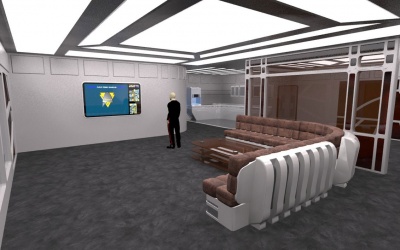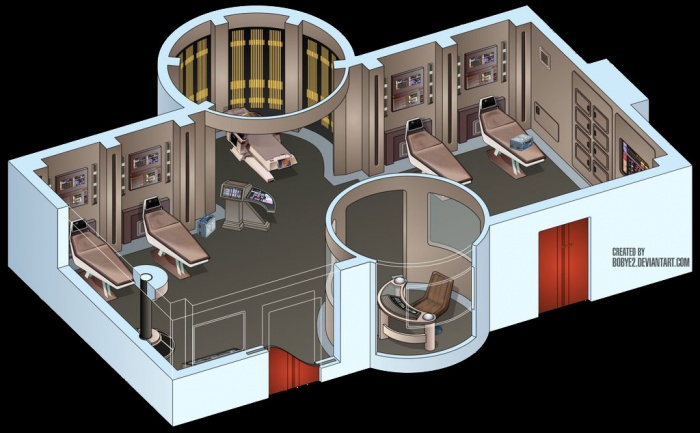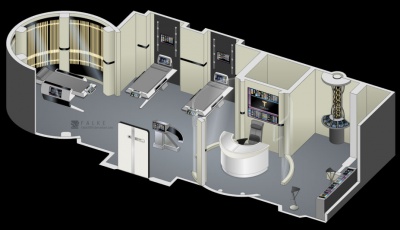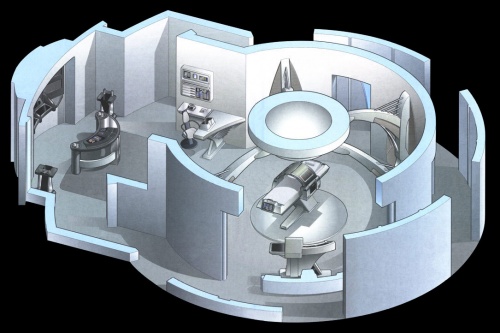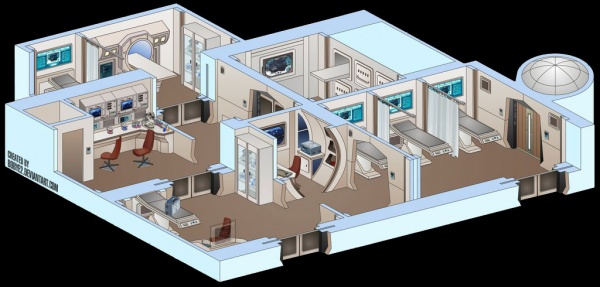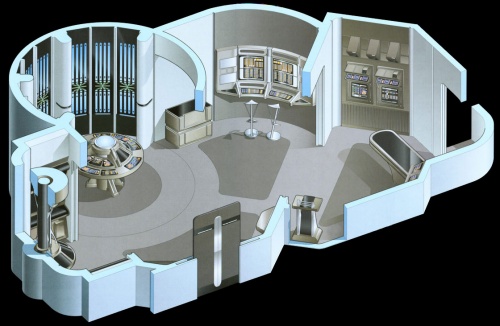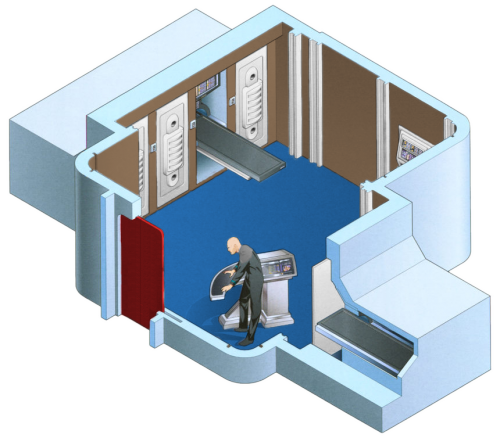Sickbay
The Black Hawk's sickbay is a massive complex located on Deck 6, able to support up to 40 biobeds running continuously, with emergency expansion to 100 in the event of a crisis (though walking room will be extremely limited.
Contents
Features
Main Sickbay
When anyone enters sickbay, they will arrive first at a waiting area. A nurse will greet the arrival and direct them from there.
Directly attached to the waiting area is the Main Sickbay, featuring four standard beds and one surgical/diagnostic cradle. The Main Sickbay is designed to function with every need the ship may have, and should the medical team suddenly need to act quickly without transferring the patient to the surgical or critical care wards.
Aboard Federation ships, a Sickbay is the main medical facility where the sick and injuried are treated. On Starbases, this is called an Infirmary. The Sickbay is overseen by a Chief Medical Officer, usually an experienced physician of several specialties. Additional doctors and Nurses also assist in monitoring and serving the general health of the crew. The area was also used for certain analyses of new lifeforms a starship might encounter, and for developing treatments for unknown diseases and illnesses. This allows for the addition of Medical Lab Technicians, Physician's Mates, and other medical professionals.
Besides the crew, a Sickbay is often called upon to render assistance to people (of various species) of other spacecraft and planets. They must stand ready to deal with any contingency, from a toothache to a planet-wide epidemic to mass casualties, and do it on a moment's notice. Applied clinical medicine is only a part of what a sickbay handles. Theory, experimentation, and cataloging are also vital in a galaxy of unknowns. Starfleet medical personnel are trained to perform both.
The office located in sickbay is a consultation office only for the physician on duty. The Chief Medical Officer's office is nearby, but not directly attached to the main ward.
Chief Medical Officer's Office
- Please see Chief Medical Officer's Office.
Examination Rooms
Ten examination rooms are available for checkup, physicals, and general practice. These will be manned by a physician on duty. These can be adapted into a Maternity Ward or Emergency Ward depending on the situation.
Dental Suite
The Black Hawk features a dental suite, able to support multiple species. The attending dentist has their own office and private lab, as well as the ability to attend to three patients at a time.
Surgical Suite
Two surgical suites are aboard the Black Hawk, designed to be used when a sterile environment is absolutely required. Surgical Bays are complete, brightly-lit sterile environments and are sealed from the other areas of the medical deck. They are equipped with specialized equipment, such as the Surgical support frame and robotic actuators, that assist the surgeon in nearly every capacity. Large wall-mounted bio-displays are mounted around the bay so the surgeon doesn't need to look around for patient vital readings. Even though all sorts of tools and medicines are stocked in the bay, a dedicated replicator is on-hand to make whatever is needed.
Holographic emitters also allow the Emergency Medical Hologram to assist or in some cases, perform the surgery.
Most surgeons prefer to use the Surgical Suite at any opportunity in order to stay familiar with the facility. In a crisis, a doctor does not want to have to worry about his/her surroundings or what is available to them.
Nearby is a recovery ward, an area a patient is taken to after surgery to safely regain consciousness from anesthesia and receive appropriate post-operative care. Most Sickbays and infirmaries have surgical recovery facilities, which are generally located in close proximity to the Surgical Bays. A ward may have private rooms, or it may be a large, partitioned space shared by many patients. Each patient bay, or space, is equipped with a variety of medical monitoring equipment.
Even in the 24th Century, surgery is an invasive procedure and a patient's body needs time to heal. The amount of time a patient requires in the recovery ward will vary by surgical or diagnostic procedure and the type of anesthesia used. As the patient recovers from anesthesia, their post-operative condition is assessed by the recovery nursing staff. A physician may order analgesic or antiemetic medication for any pain or nausea and vomiting, and the Surgeon and/or anesthesiologist may come by to examine the patient.
Intensive Care Unit
An intensive care ward or intensive care unit is a specialized part of a hospital, a ship's Sickbay, or a station's Infirmary where life-threatening conditions are diagnosed and managed. Patients placed in intensive care typically require some sort of organ support (brain, heart, lungs, etc.) and invasive monitoring and/or treatment. As the name implies, intensive care requires medical care providers to spend more time monitoring and treating than they normally would. Starfleet medical protocols state that ICUs must maintain a patient to critical care personnel ratio of no lower than two to one.
ICUs are designed to give doctors and nurses unobstructed access to a patient's room at all times. Many are laid out in a circular or semi-circular layout, with a fully-manned station at the center. Rooms are equipped with specialized equipment not readily found in a typical sickbay, such as a pulmonary infusor and vascular regenerator. All biobeds are equipped with biofunction monitors, as well as treatment-specific instrument clusters. Rooms are also equipped with instant stasis fields and null-grav environments without any necessary modifications.
Medical Labs
Medical Laboratories (or simply, Med Labs) are specialized areas aboard a ship or station that serve two functions:
- To conduct tests in order to obtain detailed information on the health of a patient to assist in their diagnosis and treatment;
- Allow qualified personnel places to conduct medical experimentations and simulations to develop unique treatments and procedures.
Given 24th Century technological advances, many tests and examinations can be readily carried out and completed with a typical medical tricorder or Biobed sensor cluster. Med labs are equipped with more specific instrumentation designed for a more complete diagnosis or to assist in experiments. They are designed with interchangeability in mind and can easily be reconfigured to support more than one specific medical science. On most ships, med labs fall into two pathological categories: anatomical and clinical. Anatomic deals with the disciplines of anatomy, exo-anatomy, histology, pathology, physiology, electron microscopy, and the like. Clinical pathology handles sciences such as hematology, genetics, microbiology (immunology, virology, mycology, etc.), reproductive biology, and medical chemistry (toxicology, enzymology, endocrinology).
All Starfleet med labs are equipped to handle biohazard threats. They can be sealed and sterilized within moments (either manually or automatically by the ship/station's computer). They also have holoemitters installed to allow Emergency Medical Holograms and Administrative Medical Holograms access to the labs.
Morgue
The morgue is an area aboard a ship or starbase where the bodies of the recently deceased are stored. In a hospital, this facility is called a mortuary. Remains are kept either in refrigeration or stasis until such time that they can be identified, autopsied (in certain situations), or reliquished for burial or cremation. Morgues are typically small, allowing for the housing of only a few individuals. However, most ships have at least one Cargo Bay or Shuttlebay that can be converted into a morgue to handle mass casualties.
Hospitals and bases typically have a pathologist on staff. Most ships have a designated Medical Officer assigned to oversee the morgue, although it is not uncommon to find a pathologist on larger vessels.
Physical Therapy
Physical therapy is the treatment of disorders with physical agents and methods, such as massage, manipulation, therapeutic exercises, cold, heat , hydrotherapy, electric stimulation, sound, and light to assist in rehabilitating patients and in restoring normal function after an illness or injury. This includes assisting patients in adjusting to and living with prosthetics or medical implants. PT bays are usually equipped with specially-designed gym equipment, saunas, wading pools, weights, null-grav beds, and the like.
Physical Theraphy Facilities are only found in hospitals or on starbases and medical ships, such as those of the Olympic class. Patients requiring PT in a normal Sickbay are typically transferred to one of these facilities. Some vessels do have a Nurse or Physician's Mate that specializes in physical therapy aboard, but any needed equipment has to be replicated or done on a Holodeck.
Other Facilities
The Black Hawk also contains Four additional Wards, specifically used for crises and isolated cases, as well as a storage and supply center. These are similar in design to the Main Sickbay.
Credits
- The images for Main Sickbay and ICU were created by Bobye.
- The image for the Dental Suite was created by Falke.
- The image for the Morgue was adapted by Residual Rose of Bravo Fleet. That image, and more, can be found at the Bravo Fleet Forums.
| USS BLACK HAWK TOUR | |
| KEY LOCATIONS | Main Bridge • Main Conference Lounge • Sickbay • Flight Deck • Main Engineering • Security Complex |
| SECONDARY LOCATIONS | Captain's Ready Room • XO's Ready Room • Brig • Armory • Mess Hall • Cargo Bays • Transporter Room Science Labs • Auxiliary Control • Chief Counselor's Office • Chief Operations Officer's Office Squadron Command Center • Intelligence Center |
| LIVING AREAS | Captain's Quarters • Senior Officer Quarters • Officer Quarters • Junior Officer Quarters Senior NCO Quarters • NCO Quarters • Enlisted Quarters VIP / Guest / Civilian Quarters • Fighter Pilot Quarters |
| OFF DUTY & LOUNGE | Holosuites • Holodecks • Talons • USS Black Hawk War Time Memorial • Recreation Room • Library • Arboretum |
